
 Jeff Sundin Fishing Report September 30, 2018 "Aggressive Tactics for Slab Crappie"
Jeff Sundin Fishing Report September 30, 2018 "Aggressive Tactics for Slab Crappie"
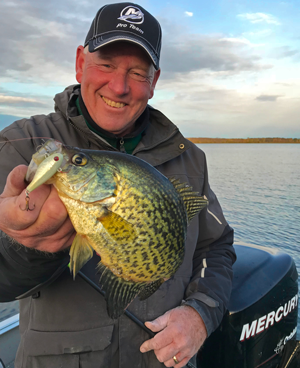 Skipping over the finesse section of my tackle box turned out to be a good idea on Saturday.
Skipping over the finesse section of my tackle box turned out to be a good idea on Saturday.
Before I got the idea to make the switch, we used all of the standard tricks for catching suspended Crappies; and they worked. Jig and minnow, yes we caught fish on them, Lindy Ice Worm tipped with waxies, yes we caught fish on that too and we even caught some fish on small, finesse style artificial lures. If we would have continued fishing vertically using these classic fall presentations, we would have certainly left the lake with plenty of fish.
The thing is I was seeing lots of small schools of fish scattered across a flat in 20 to 21 feet of water. Moving from one school of fish to another was okay, but I wondered what would happen if we moved faster and used larger, more aggressive lures. Would it be possible trigger more reaction strikes and target larger fish both at the same time?
During a pit stop on shore, I went ahead and rigged up 1/8 ounce Lindy Jigs and added 3-1/2 action tails. I mentioned that I wanted to try an experiment; I knew that the lures looked sort of large, but that I just wanted to see how the fish reacted to them.
We motored back to the crappie hole, got in position for a drift and fired our jigs out there. “Fish ‘em just like you’re snap jigging for walleye I said. Hop ‘em, swim ‘em, lift and drop, just keep the lures moving.”
I can’t remember who caught the first one, but I do remember that it took all of about 2 minutes to do it. The faster moving presentation worked like a charm, every time we saw a pack of fish on the Humminbird, somebody caught one. The average size of the fish increased too, we went from sorting through 8 to 10 inch fish, to catching plump, 11 and 12 inch fish.
Another experiment came to mind, I wondered if jigging lures like the Lindy Darter would produce the same results. I tied one on, tossed it into the water and started jigging with a lift-snap-drop motion. In a couple of minutes I was getting strikes on the Darter just as fast as we were on the jigs and soft plastics.
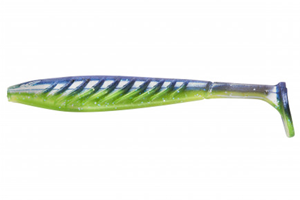 The upshot, I think, is that when you see schools of fish spread out horizontally, it’s a good idea to take a swing at them using faster moving presentations. Selecting for larger fish by using large lures makes some sense too; in our case the improvement in size was amazing. Obviously there have to be some larger fish present for that to work, so knowing the size structure of fish in your lake is important. If there are big ones in there, then this idea might pay off bigtime for you.
The upshot, I think, is that when you see schools of fish spread out horizontally, it’s a good idea to take a swing at them using faster moving presentations. Selecting for larger fish by using large lures makes some sense too; in our case the improvement in size was amazing. Obviously there have to be some larger fish present for that to work, so knowing the size structure of fish in your lake is important. If there are big ones in there, then this idea might pay off bigtime for you.
We experimented with lures that I happened to have on hand, but there’s room for more experimentation. The 1/8 ounce Lindy Jigs are good because they have a barbed collar for holding soft plastics securely. They pair up nicely with action tails in the 3 to 4 inch range. I think you could use a variety of action tails, but YUM has some nice items like the Pulse and Ribbon Tail Grub. The Darter worked well too, in fact it worked well enough that I’m going to increase my supply and experiment with them in other situations throughout the fall too, I’ll be sure to let you know how that goes.
Remember the article I wrote about fishing for perch in the “fuzzy stuff” a few weeks ago? In it, I mentioned that I thought it was called Eelgrass and referred to its appearance on my Humminbird as “fuzzy stuff”. Thanks to Tim James, we now have more information about the plant.
On 9-29-19 Tim wrote; “You surely must be talking about wild celery. As with most aquatic vascular plant identification, it is best to have a sample in hand rather than rely on photos off the web, but having said that, you may want to consider looking at several source descriptions of Vallisneria. I am confident that that is what you have described.”
Vallisneria Americana, aka Wild Celery is definitely the plant that I was referring too. The link provided spells out the details and provides an excellent photo of the plants. Learn More >> Vallisneria Americana.
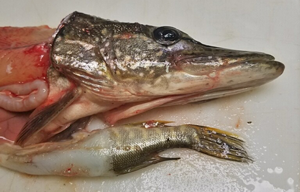 The new protected slot size regulations for Northern Pike have both its good side and its bad. On one hand, we’ve had to release many of the fish that we previously considered to be the ideal sizes for eating. On the other hand, if we’re willing to be proud of smaller fish, then we are allowed to harvest a lot more fish than we could before.
The new protected slot size regulations for Northern Pike have both its good side and its bad. On one hand, we’ve had to release many of the fish that we previously considered to be the ideal sizes for eating. On the other hand, if we’re willing to be proud of smaller fish, then we are allowed to harvest a lot more fish than we could before.
I have had a handful of customers this season who are willing to be proud of the small pike in order to gather more fish for the table. On Friday, my new friends Wayne and Ben Hamre became the most recent addition to my list of names. With a goal of 20-21 inches as the “keeper” size range, we managed to harvest 8 pike and while I was cleaning them, something interesting happened. Of the 8 fish, the stomachs of 4 of them contained small, young of the year pike; that’s right, they were cannibalizing their own young.
According to Gary Barnhard, Bemidji Area DNR Fisheries Manager and author of the original pike regulation proposal, this is good news. Part of the management strategy is supposed to be that larger pike will eat smaller pike and help create more space in the lakes for pike to grow larger, faster.
A couple of weeks ago, I stumbled into a doubting Thomas when I read somebody's post about Northern Pike and the new slot size regulations in that big social media chat room. In the post, the writer argued that he had never seen or heard of any pike that ate any other pike, no matter the size.
The photo shown here represents an opportunity to learn the learnable. Pike will and do cannibalize each other and the more large fish we protect, the faster they can do it.
Let’s say that you believe Northern Pike are eating too many small walleyes and that walleye fishing would improve if pike weren’t so plentiful. Then why not be part of the solution? Slap a few of those small pike into your livewell and use them to make a fabulous dinner. If you do, there’s no doubt that you will have served your fellow anglers and just maybe, you’ll save one walleye that grows up to be your trophy of a lifetime! ![]() - Jeff Sundin 218-245-9858 or EMAIL
- Jeff Sundin 218-245-9858 or EMAIL
 Jeff Sundin Fishing Report September 28, 2018 "Vegetation Die-Off Improves Access To Fish"
Jeff Sundin Fishing Report September 28, 2018 "Vegetation Die-Off Improves Access To Fish"
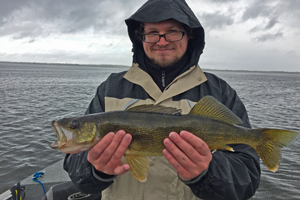 Water temperatures continue to fall; we found 54.8 degrees on the calm side of our lake yesterday. At 55.2 the windy side was somewhat warmer, but still plenty chilly. I read a post from Bill Powell at Fred’s Bait who found 57 degree water on the lake he was fishing and an emailer reported 58.5 degrees on Leech Lake’s Walker Bay.
Water temperatures continue to fall; we found 54.8 degrees on the calm side of our lake yesterday. At 55.2 the windy side was somewhat warmer, but still plenty chilly. I read a post from Bill Powell at Fred’s Bait who found 57 degree water on the lake he was fishing and an emailer reported 58.5 degrees on Leech Lake’s Walker Bay.
Despite the cool temperatures, some of the weed varieties remain Green and healthy and in many lakes, these remain the focal point of fish activity. There are some weed varieties in serious decline though and I’m really happy about one of them.
You may have seen those long, pale Green, skinny, stringy plants that spiral from the bottom to the surface. Those are the ones I’m talking about and I’ve been Googling every name I can think of, but still find an image that matches up correctly. Those mystery weeds frustrated me more than a few times during the summer. Fish that were holding in heavy patches of them were almost impossible to catch because there was no way to run a lure, much less a boat through them without getting all fouled up.
Now that these, along with some of the other least hearty weed varieties are dying off, we can get our lures into areas where we couldn’t fish before. That’s been paying off for me over the past few days by providing us with a mixed bag of Walleye, Perch and Northern Pike.
Key areas are wherever Green Cabbage and Coontail patches lay adjacent to flats where these weed die-offs are occurring. For me, the key depth has been about 8 feet of water and there have been numerous times when one of us has caught fish at the same time another is dragging up a jigful of black, decaying vegetation.
After fishing the pattern for two days, I’m still scratching my head about what makes fish tick. Both days were like a pike-fest, we caught upwards of 50 of them each day, but on Wednesday, pike ran larger than they did on Thursday.
Walleyes came along occasionally too, but the size structure we caught between the two days was the reverse of the pike. Wednesday offered us more “keepers” than slot-fish, while Thursday provided mostly fish of larger “protected slot” sizes like the one you see Tyler Johnston holding here. Why there would be an inverse relationship between sizes of the two species on consecutive days is a mystery to me.
Perch ran the same size on both days, but we bagged more of them on Thursday than we did on Wednesday.
Weather was a key influencing factor, in clam water, we caught more walleye and perch than we did in rough seas. In fact, the rougher the chop was, the more aggressive hammer handle size pike became and eventually, it became difficult to fish without getting our jigs snipped off. Adding a leader made of heavy fluorocarbon helped protect against bite-offs, but reduced the number of strikes significantly.
Watching the forecast, I have the impression that this will be a weekend for “die-hard” anglers. Overnight lows at or near freezing and daytime highs in the 40’s; not exactly skinny dipping weather. Cold temperatures aside, the fish do appear to be cooperative and reports get a little better each day.
If you’re on your way to the lake, bundle up, have fun and do me one little favor. Connect and use the safety cord from the kill switch on your outboard.
There have been at least two incidents of anglers being thrown out of their boats this summer without having the safety devices connected. One of them was luckier than the other, but neither of them got out of their situations without serious distress. I promised the Hippie Chick that I will use mine and I will; if something does go wrong on the lake, at least my boat won’t drive away without me. ![]() - Jeff Sundin 218-245-9858 or EMAIL
- Jeff Sundin 218-245-9858 or EMAIL
 Jeff Sundin Fishing Report September 27, 2018 "Bagging the Baggable"
Jeff Sundin Fishing Report September 27, 2018 "Bagging the Baggable"
On Wednesday, I shuttled my crew to a couple of lakes that I hadn’t fished for a while. Both of them are on the shallower end of the spectrum and both of them have dark water that supports heavy algae blooms during summer.
I anticipated that the water would be cooler than it’s been in other areas I’ve fished recently. Still, I was surprised by how fast surface water temperatures had already fallen. At 56 degrees, they were the coolest waters that I’ve fished so far this fall.
No matter where you fish, shallow water lakes like these are always the first ones to cool down during fall. Typically, that makes them good choices for anglers who want to get in on the “pre-turnover” period. That’s because fish in these waters get the signal that fall is here earlier than their cousins who live in deep water lakes. That’s why we were there, to check out the theory.
I do believe that the fish were biting on the first lake, but evaluating my theory wasn’t easy because we didn’t stick around long enough to discover any large schools. When I did mark fish on the Humminbird, they struck, but I never found more than singles and doubles.
On that lake, it’s not unusual for it to take me a few hours figure out where the best schools of fish are hiding. There’s a ton of structure and almost all of it is located in shallow water; it takes time to check it all, but I usually do find the right spot; eventually. But the winds were strong on Wednesday, whitecaps made fishing conditions uncomfortable and besides, I was scheduled to cook a shore lunch anyhow.
Torn between staying there and giving the lake a thorough examination vs switching over to smaller, calmer waters, I used the shore lunch as an excuse to make the change.
At Lake Two, the search for fish went a little bit faster, Tyler began catching pike within minutes of stopping at the first spot and Steve caught a keeper walleye there as well. I might have stuck around that area longer, but we were still fishing in a lot of whitecaps and I decided to try a shallow weed flat on the calm side of the lake; that was a good idea.
The outer edge of the weeds contained some walleyes, a few perch and a ton of Northerns. For many, the pike might have been considered a nuisance, but the boys had just eaten one that was included in our shore lunch. That fish, delicious if I do say so, gave the boys a good reason to enjoy catching and harvesting some more of them.
I held the boat in about 8 feet of water, just outside the heaviest weeds. We cast 1/8 ounce live bait jigs tipped with large Rainbow Chubs toward the weed flat and fished with a vertical hop-drop-hop motion back toward the boat. Every strike was a little different; we never knew what fish we were gonna catch next.
The one problem with this style of fishing is figuring out which fish is striking and knowing the correct timing for setting the hook. After we got our jigs snipped off by a few pike, we began getting jumpy, setting the hook too quickly and missing both walleye and perch strikes. To hook a walleye or a perch, staying calm and waiting out the strike is crucial to getting a strong hook set. We recorded a video that demostrates the technique and you can view it here >> Strikes When Jig Fishing For Walleye Wait Them Out
I’m convinced that there were more than a few perch in that area because I could feel them picking away at my bait. The presence of all those pike, along with the colder water induced their semi-negative mood and that’s why we he had trouble hooking more of those strikes. The walleyes, when they struck offered the classic, slow pull-down and were not that difficult to hook. All we needed to do was waiting longer to ensure that they had fully taken the bait; but again, we were often too jumpy.
By our standards, the fishing was good enough to justify a return trip to that lake today. Along with releasing some protected slot-fish, we managed to bag 6 keeper walleyes, a few perch and 7 pike of reasonable size. We’ll almost certainly be able to finish off the remaining 13 fish of the liberal 20 pike bag limit for 2 people. If we get lucky, we’ll move closer to their walleye limit too and add some jumbo perch to the larder while we’re at it.
While I was cleaning the pike last night, there were a few spectators marveling at how simple removing the so-called “Y-Bones” from the pike really is. An angler with average fish cleaning skills can learn to do after only a few tries and if you like to eat fish, there is no excuse not to come home with enough pike or a fabulous meal. I wish more folks would give it a try.
By the way, Outdoor Bound TV recorded a show with me last summer. We fished for pike, demonstrated how to clean them and then offered up one fabulous recipe for cooking them. You can view the show here >> Outdoor Bound Lake Winnie Pike Fishing ![]() - Jeff Sundin 218-245-9858 or EMAIL
- Jeff Sundin 218-245-9858 or EMAIL
 Jeff Sundin Fishing Report September 26, 2018 "Fall Peak Walleye Fishing"
Jeff Sundin Fishing Report September 26, 2018 "Fall Peak Walleye Fishing"
On Tuesday, the surface water temperatures where we fished held at 60 degrees throughout the day. Historically, this temperature has been the point of natural resistance, when most lakes water temperatures pause briefly before taking the next plunge downward.
Now is the time when walleye anglers will have their chance to get in on fish that feed both more aggressively and for longer periods of time each day. The bite isn’t automatic, local weather conditions still dictate feeding trends from day to day and do need to be taken into consideration. But this is the time when the odds are definitely tipped in favor of the angler.
On Tuesday, weeds were still green, healthy, and once again the focal point of our fishing strategy. I looked for signs that walleye had abandoned the weed lines, scanning deeper water each time we moved from one spot to another. In my travels, there wasn’t much sign that many fish had taken up residence on deeper structure. Except for a few random sightings of single fish, I could not find a spot in open water that looked attractive to me.
The fish we found were semi-active, they struck our jigs and minnows willingly, but he had to fish slowly in order to elicit a strike. Casting or trolling produced far fewer fish than simply dropping the jig over the side and holding the bait still. In our case, semi-active was active enough and if I could see fish on my Humminbird, we could usually get them to strike. That’s why I didn’t try any faster moving presentations, the jig and minnow is the only presentation we used.
Questions about the fall turnover started popping up yesterday, so it’s timely to remind you about an article I wrote on that subject last year.
“One key to consistent catches of fish during late autumn lies in understanding how fish and their forage respond to falling water temperatures. Just because water temperatures turn cold, lakes turn over and fish disperse, doesn't mean that they won't feed or that they aren't catchable, they are.
During fall, many lakes undergo a transformation known as the fall turnover. Not every lake turns over, and the effects of turn over can't always be measured equally between lakes. Getting a handle on how fish respond to these transformations is what makes us better cold water anglers.
Your favorite lake might undergo a turnover, or it might not; depending on who you ask, getting an answer in simple layman's terms might be tricky, but before you can plan your fishing strategy, you do need to …” Read >> Fishing The Fall Turnover In Natural Lakes
The top item on today's agenda is walleye fishing and I don't think there's much wiggle room to use the "mixed bag" strategy as a hedge against slow action. I'm still scratching my head about where we'll go or how I'll find a 100% pure walleye bite, but I'm gonna give it everything I've got! ![]() - Jeff Sundin 218-245-9858 or EMAIL
- Jeff Sundin 218-245-9858 or EMAIL
 Lake of the Woods, LOW Tourism September 25, 2018
Lake of the Woods, LOW Tourism September 25, 2018
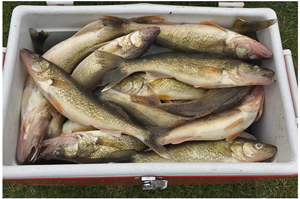 "On the main basin... Good fall walleye fishing continues. Jigs and frozen shiners working well in 28-32'. Anchor up and jig. If not finding fish, drift with spinners or troll crankbaits to find active fish. Fish starting to stack in front Pine Island and other south shore locations. Some days fish are sliding shallow. Shiners continue to run up the Rainy River.
"On the main basin... Good fall walleye fishing continues. Jigs and frozen shiners working well in 28-32'. Anchor up and jig. If not finding fish, drift with spinners or troll crankbaits to find active fish. Fish starting to stack in front Pine Island and other south shore locations. Some days fish are sliding shallow. Shiners continue to run up the Rainy River.
On the Rainy River... Shiners are running. Walleyes are just starting to enter river. Anglers reporting success both jigging and pulling crankbaits. Increased sturgeon activity. Walleye activity is increasing as shiner run continues.
Up at the NW Angle... Fishing is excellent. Strong numbers of walleyes being caught on mud flats and adjacent to islands. 15 - 25'. Spinners, crankbaits and jigging all still producing. Walleyes starting to move towards structure and outside mouths of bays. Crappie activity strong, guides helpful for crappies" – Lake of the Woods Tourism, (800) 382-FISH
 Lake of the Woods, Border View Lodge September 25, 2018
Lake of the Woods, Border View Lodge September 25, 2018
"Fall weather has officially set in and we are ready! Fishing, Duck hunting, Grouse hunting, take your pick.
Anchored and jigging with a Shiner minnow has been the best presentation this past week. We have been spending most of the time along the Border in Big Traverse or Little Traverse this past week.
Temperatures from the 30’s to 50’s are forecasted for the week ahead.
We are booking for winter, give us a call to lock in your dates!" - 1-800-776-3474 Border View Lodge
 Jeff Sundin Fishing Report September 24, 2018 "Water Temperatures Enter Ideal Range"
Jeff Sundin Fishing Report September 24, 2018 "Water Temperatures Enter Ideal Range"
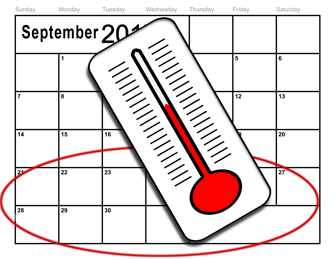 Surface water temperatures dropped from 63.0 degrees to 61.5 degrees between Saturday and Sunday. A rainy, cool day today should encourage a little more slippage, but after that, I’ll bet that temperatures are going to stall out for a short time. Historically, that's been a typical fall scenario; once temperatures reach about 60 degrees, there's some natural resistance before making the next plunge.
Surface water temperatures dropped from 63.0 degrees to 61.5 degrees between Saturday and Sunday. A rainy, cool day today should encourage a little more slippage, but after that, I’ll bet that temperatures are going to stall out for a short time. Historically, that's been a typical fall scenario; once temperatures reach about 60 degrees, there's some natural resistance before making the next plunge.
Temperatures locked into the low 60's will mean that walleye fishing should get more reliable by the day. If you can find them, they should be willing to strike. You’re asking, find them where and strike on what? The answer is anyplace where there’s a lot of food.
Over the past few days, the more bait I see on my electronics, the more predators I find in the surrounding area. Some of the locations have seemed like unlikely hiding spots for Walleye, but weedy, soft bottom flats and shallow bays with no particular structural features have held enough fish to make life interesting. None of these areas would probably appeal to a walleye purist, but when we’ve been willing to sort through small perch and pike, we do bag walleyes along the way as well.
I think that one reason I’ve found fish in off-beat locations and haven’t found as many walleyes stacked up on classic fall spots is that weeds are still green and plentiful. Once more of the weeds die off, then under water points, rocks and steep breaklines will attract more fish. Until then, I’m just trying to be creative, keep the boat moving and wait until I see a lot of life on my screen before wetting a line.
Like I said yesterday, jigs and minnows have become reliable producers for me. I’m paraphrasing a note from Chris Fosse that said something like; “We fished with leeches on Saturday and while our supply lasted, crushed the walleyes on them. After that, we caught a little bit of everything.” I don’t know how easy it will be to find a supplier of good leeches right now, but if I do, I will take Chris’ advice and pack some into the cooler.
Until now, the slow downward progression of water temperatures and the sluggish build up to fall walleye action has tracked close to the same time frame as last year. During the 2017 season, unseasonably warm conditions delayed fall walleye action from really heating up until the 1st week of October. But compare the high temperature of 80 degrees on September 24th, 2017 with today's forecast and its easy to see why this may be the week that the similarities change. I see a lot of cooler overnight temperatures in the forecast forecast for this week and if they hold true, we might see the uptick in walleye action arrive a little earlier this season.
As I write this report, I’m watching the lightning and listening to the rain fall on the roof of my house. It’s uncertain whether or not I will actually wind up on the lake today, or if Mr. C. will decide to take a pass. Either way, I will definitely report the reportable on Tuesday morning. In the meantime, stay dry and have a fabulous Monday! ![]() - Jeff Sundin 218-245-9858 or EMAIL
- Jeff Sundin 218-245-9858 or EMAIL
 Jeff Sundin Fishing Report September 23, 2018 "Falling Into Fall Walleye Fishing Patterns"
Jeff Sundin Fishing Report September 23, 2018 "Falling Into Fall Walleye Fishing Patterns"
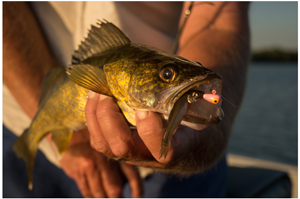 Surface water temperatures have fallen into the low 60 degree range on most Itasca area lakes. Fishing in 63 degree water, my crew this Saturday enjoyed the first day (for me) that jig and minnow presentations outperformed trolling patterns which until now, have provided most of the walleye action for us.
Surface water temperatures have fallen into the low 60 degree range on most Itasca area lakes. Fishing in 63 degree water, my crew this Saturday enjoyed the first day (for me) that jig and minnow presentations outperformed trolling patterns which until now, have provided most of the walleye action for us.
During a typical fishing season, Saturday’s results would be my que that for a time, walleye fishing will become more reliable by the day. It’s obviously going to depend on how the weather breaks, but leading indicators are positive that the fall bite has begun. Occurring on the day of the Autumnal Equinox makes it feel more official too, or at least more fun.
Walleyes hadn’t strayed too far from the weed edges and catching them meant putting up with frequent bite offs from small northern Pike, so that means jig sales are up! But there were enough walleyes on the weedlines to allow my crew a very respectable bag of 10 keeper size walleye along with some bonus perch for the table. We caught some smaller fish too, but catching "our limit" wasn’t crucial, so they were released, hopefully to be caught again next year.
Now that the jig and minnow bite is on, finding the right minnows to use will become immensely important. On Saturday, we used 1/8 ounce Lindy Live Bait Jigs tipped with fatheads and I believe it helped when I sorted through the bucket and pinned on the largest ones I could find. There are always exceptions, but while you may catch enough fish using sub-standard bait to make it feel like you’re getting the right stuff. Your ratio of successful fishing trips will definitely go up if you fish with really good minnows though and I believe it’s worth the effort and expense of finding premium bait.
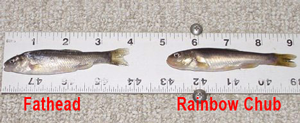 Size rather than species is what I pay the most attention too; I will fish with almost any minnow as long as they are in the correct size range. At the bait shop, I watch most folks walk right by the fatheads and look for shiners, actually I do it too, but not because I don’t like fatheads. I would fish with fatheads every day as long as they are big fat ones, somewhere in the 3-1/2 to 4-1/2 inch size range. Golden Shiners, Rainbow Chubs, Spottails, Dace, Brassy Shiners, even small Sucker Minnows will work if they fall into that same size range.
Size rather than species is what I pay the most attention too; I will fish with almost any minnow as long as they are in the correct size range. At the bait shop, I watch most folks walk right by the fatheads and look for shiners, actually I do it too, but not because I don’t like fatheads. I would fish with fatheads every day as long as they are big fat ones, somewhere in the 3-1/2 to 4-1/2 inch size range. Golden Shiners, Rainbow Chubs, Spottails, Dace, Brassy Shiners, even small Sucker Minnows will work if they fall into that same size range.
Considering the expense of buying good minnows and the complications that arise from following the invasive species regulations, I’ve set up a “bullet proof” system for keeping my bait alive, legally before, during and after my fishing trips.
The system consists of a marine grade cooler located in the bed of my pickup and filled daily with fresh well water. I use a 12 volt aerator connected to a small deep cycle battery to pump fresh air into the water at all times. To make sure my system never goes down, I’ve installed a solar panel that charges the battery during the day and keeps the aerator running overnight.
The entire setup cost me about $250.00 at full retail pricing and while I realize that my system would be overkill for most of you, it would be easily duplicated on a much smaller scale.
You’re asking how long it takes to save $250 worth of live minnows. For me, I will recover the entire cost of the system over the next 30 days. After that, my boss promised me a bonus for every minnow that doesn’t get wasted! ![]() - Jeff Sundin 218-245-9858 or EMAIL
- Jeff Sundin 218-245-9858 or EMAIL
 Jeff Sundin Fishing Report September 22, 2018 "A Well Desrved Testimonial For Maki Auto Body"
Jeff Sundin Fishing Report September 22, 2018 "A Well Desrved Testimonial For Maki Auto Body"
 Fishing this week has been a roller coaster ride, a day of fabulous action on Wednesday, followed on Thursday by a wet, cold day on a lake where the fish had apparenty gone dormant since my last visit.
Fishing this week has been a roller coaster ride, a day of fabulous action on Wednesday, followed on Thursday by a wet, cold day on a lake where the fish had apparenty gone dormant since my last visit.
By the time we got the boat cleaned up, inspected and ready for a swing at another lake, more external problems cropped up and forced an early ending to our day.
In terms of running a smooth operation, it’s been a rough week all the way around for me. Flat tires, engine problems, electric problems, leaky stuff, noisy stuff and the most irritating of all; the door latch on my pickup truck that was stuck shut.
I’m not sure that any of us fully appreciates how nice it is to have a door that simply opens and closes as it should. But when you have one that doesn’t and you have to crawl in from the passenger side every time you want to launch your boat, it definitely gets your attention.
An unexpected family problem forced my crew to head home early, leaving me with a day off the water on Friday. That gave me a chance to take a swing at getting at least some of my broken stuff repaired. High on the list was my stuck truck door.
Long story short, I swung into Maki Auto Body in Grand Rapids, where I’d hoped that I could get a bit of advice on how to go about getting the door open. Instead of advice, I got the red carpet treatment. Dylan Maki dropped whatever he was doing, jumped into my truck and started tracking down my trouble. Others joined in and offered helpful advice along with a few extra pounds of muscle power. Soon, the door was open, the problem solved and I was smiling from ear to ear.
Everybody loves getting help from a friend and I am truly grateful for the help I got from Dylan Maki and his crew; that was above and beyond! But the point of this note goes beyond that because while I was in the shop, I swerved into a discovery even more pleasant and less expected than the royal red carpet treatment they gave me.
Watching the Maki crew at work was amazing, there was music playing, cheerful people smiling and whistling and getting work done; apparently without effort. It was the kind of experience that opens your eyes, because we see so little of excellence these days. What I saw was the kind of shop that anybody would feel really good about recommending to a friend. So that’s what I’m doing, recommending that if you ever find yourself in need of an outstanding auto body shop, please do me a favor and visit Maki, I don’t think you’ll be disappointed!
Since I wasn’t on the water yesterday, I don’t have a ton of new news about fishing. But I do know that the morning rain and blustery winds encouraged me to be happy about my forced benching. Few of my friends were on the water either and of the ones who were, nobody made me feel like I missed out on anything special.
But here we go, it’s officially the first day of fall and I’m back on the water today. In fact I’ll be on the water every day this week and I’ll have plenty of fresh updates about fall progressions as they unfold.
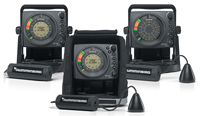 2018 HUMMINBIRD ICE FLASHER PROMOTIONS
2018 HUMMINBIRD ICE FLASHER PROMOTIONS
Purchase a qualifying model between 9/1/18 and 12/31/18 and receive up to $55 MASTERCARD Prepaid Credit Card.
QUALIFYING MODELS — ICE 55 FLASHER (#407040-1) — ICE 45 FLASHER (#407030-1) — ICE 35 FLASHER (#407020-1) Submit your rebate ONLINE ONLY by 1/31/19
Learn More >> Humminbird Ice Promotions
 Jeff Sundin Fishing Report September 20, 2018 "Perfecting the Perfectable"
Jeff Sundin Fishing Report September 20, 2018 "Perfecting the Perfectable"
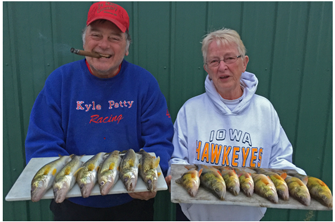 Surface water temperatures remain warm, on Wednesday they held steady at 66 degrees until just before we left the lake at 5:30 PM. That temperature ranges 3 to 4 degrees warmer than the ones I recorded on the same date last year, which was already considered unusually warm in my estimation.
Surface water temperatures remain warm, on Wednesday they held steady at 66 degrees until just before we left the lake at 5:30 PM. That temperature ranges 3 to 4 degrees warmer than the ones I recorded on the same date last year, which was already considered unusually warm in my estimation.
The warmer than average temperatures may be delaying the arrival of a full-scale fall walleye bite, but I do see signs of improvement. In fact, Wednesday was the first day in recent history my crew, Kyle and Karen Reynolds bagged a full 12 fish limit of walleye on a single day trip.
The improvement may not be completely weather related though. Yesterday we strayed from the jig and minnow presentation which has produced more Jumbo Perch than anything else over the past week.
There hasn’t been a lot of reason to switch, the 1/16 ounce Live Bait Jigs tipped with minnows have been awesome for catching Perch. For the most part, that’s all we’ve wanted to catch, so I’ve stuck with that program. But on most days, I’ve spent some time experimenting for walleyes fishing deeper structure using jig and minnow combinations, but with only limited success.
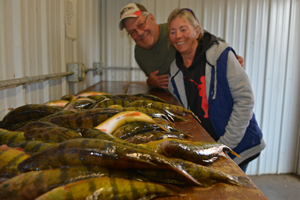 Yesterday, I wondered if the warmer water might allow me to mix up the bag by returning to trolling spinners along the weed edges. That approach would surely produce some pike, a desirable species for my crew; in fact pike are actually Karen’s favorite. So I started the day fishing the same areas that we’ve fished for perch, patches of Eelgrass located on shoreline flats.
Yesterday, I wondered if the warmer water might allow me to mix up the bag by returning to trolling spinners along the weed edges. That approach would surely produce some pike, a desirable species for my crew; in fact pike are actually Karen’s favorite. So I started the day fishing the same areas that we’ve fished for perch, patches of Eelgrass located on shoreline flats.
For attracting pike, the spinners tipped with fatheads were an instant success. In fact I think we caught 5 or 6 pike within 5 minutes of stopping at the first spot. Occasionally, we caught perch too, but fish over 10 inches were harder to come by using the spinner and minnow than they were previously using the jig and minnow. The size of the pike was all over the map, anything from 12 inches to 25-3/4 inches struck the lures. We did not catch any pike over the 26 inch size restriction, but we did bag some fish that were in the 21 to 21-1/2 inch range.
Walleyes didn’t show up in good numbers right away, but we did release a few small ones early. Either it took me until mid-day to find them, or else that’s just when they began getting active, but our best walleye fishing was from 1:00 PM to 5:00 PM.
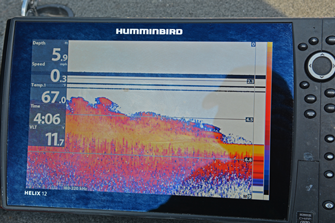 Perch did strike throughout the day and we did bag 24 10 to 12 inch fish, so we were happy. But there’s no doubt that the trolling presentation produced fewer perch and that they averaged smaller. I’m confident that we could have bagged more perch by jigging, but it probably would have been at the expense of catching the other fish.
Perch did strike throughout the day and we did bag 24 10 to 12 inch fish, so we were happy. But there’s no doubt that the trolling presentation produced fewer perch and that they averaged smaller. I’m confident that we could have bagged more perch by jigging, but it probably would have been at the expense of catching the other fish.
Key depths ranged from 4 to 9 feet with perch favoring the shallower water and walleye holding deeper, toward the base of the weed edges. For either species, the presence of vegetaion was a must, clean breakline areas held very few fish.
In the report on September 16, 2018, I described the type of vegetation where we’ve been locating these fish. Yesterday I snapped a photo of my graph so you can see what the Eelgrass looks like on the screen. If you compare that to the underwater photo I shared in the report, it should give you a fairly good idea of what you’re looking at when you see it.
Like I said, Kyle and Karen like their pike and that’s what we have scheduled for today. This will be the 2nd time this season that I’ll arrive at the lake with intention of “filling out” bag limits of pike under the new 10 fish law.
I can’t see any reason why more folks wouldn’t want to take advantage of the opportunity, if you sort out the 21-22 inch fish, they are ideal for cooking and there are numerous excellent recipes available. Besides that, we may catch upwards of 100 fish during the time it takes to sort out the ones that they want to eat. That kind of action is hard to beat, especially when you’re fishing with youngsters, or anybody who has a touch of the A.D.D. like me. ![]() - Jeff Sundin 218-245-9858 or EMAIL
- Jeff Sundin 218-245-9858 or EMAIL
 News Release September 21, 2018 — DNR seeking input on Leech Lake proposed walleye regulation change
News Release September 21, 2018 — DNR seeking input on Leech Lake proposed walleye regulation change
"A proposed walleye regulation change on Leech Lake would allow anglers more opportunities to keep walleye beginning when the 2019 open water fishing season opens.
The Minnesota Department of Natural Resources is seeking input on the change at an open house from 6 p.m. to 8 p.m., Monday, Sept. 24, at the Walker Area Community Center.
The proposed regulation change would remove the 20- to 26-inch protected slot and replace it with a regulation similar to the statewide regulation, but with a four-fish walleye limit, only one of which can be over 20 inches.
The current walleye regulation on Leech Lake is ..." Learn More >> Proposed Leech Lake Walleye Regulation September 21, 2018
 Jeff Sundin Fishing Report September 19, 2018 "Advising the Advisable"
Jeff Sundin Fishing Report September 19, 2018 "Advising the Advisable"
As I was doing my obligatory flip through of the social pages yesterday morning, I stumbled into a post from an angler who had recently visited Minnesota on a fishing trip. He’d posted some words of wisdom about how he and his group found and caught walleyes despite being advised by numerous “inside sources” that the walleye bite had been too tough to tackle for most anglers in that area.
In a way, it felt like he was castigating bait store owners, guides and bloggers for giving bad advice about fishing. But at the same time, I picked up on a certain sense of humility about the way his comments were phrased. About a half hour after reading his post, I thought to myself that he’d made some valid points and that passing his advice along to you might have some merit.
I logged back in hoping to both to peruse the post more carefully and to ask for permission to quote his comments in today’s report.
Unfortunately “social media” isn’t very social when it comes to re-discovering a post from the past, especially since I didn’t recall the author’s name. I never found my way back to his original comments.
No matter, I still recall the essence of his commentary and I did think he gave some good advice. So please understand that I’m paraphrasing, but his comments were something along these lines.
“Don’t be over-dependent on fishing information that you get from others. Take the advice of fishing blogs, bait shops and resort owners for what it’s worth. Give suggested presentations a try, check out the advised depth ranges, and pick up a few of the so-called hot lures. But if their advice doesn’t work, strike out on your own to figure out a fishing strategy that works for you.”
Toward the end of his post, he added that no matter where you are, or what time of the season you’re fishing, the fish are always biting somewhere. His post also included photos of a bunch of walleye that were lined up on a picnic table outside of the lake cottage. Obviously they were the fish caught by his group during their stay in Minnesota.
He did not share much about where they caught the fish or how; in fact I don’t recall that he even mentioned which part of the state his group was visiting. But that’s okay; I still think that the overall sentiment of his narration was good.
It reminded me too about how easy it can be for guys like me to give folks the wrong impression about how good, or not good the fishing action is at any particular time and place. Just because I have a pattern dialed in does not mean that everybody could capitalize on it. Conversely, just because I don’t have a pattern dialed in doesn’t mean that nobody does and while I’m struggling to catch a fish on one lake, another angler may be catching them on the other side of the same lake.
Frequent readers have seen me write a thousand times that most of my better fishing experiences were the result of good timing and good luck. Knowledge about fishing doesn’t even come in to play until the moment that I “stumble” into whatever opportunity comes along. However, once an opportunity is revealed, knowing what to do about it will help put icing on the cake.
An angler could motor across the lake armed with GPS coordinates, hot tips and personalized advice from every big time pro in the state and still not succeed. That’s because weather changes, baitfish locations and the feeding preferences of predatory fish are constantly changing. The only way to cash in on any so-called “hot tip” is to be there at the precise moment that the information was given to you.
Hopefully by now you’ve noticed that my reports are written in such a way that allows anglers to glean tidbits of good information, rather than as the “hot tip” of the day. I love it when I hear from anglers who say that they learned about a presentation from me and then applied the information to their own fishing situations and succeed. That makes getting up every morning to write these reports worthwhile to me.
I try to be sure that my own reports are accurate, positive and up-beat as possible. But I do admit that I also have a tendency to report my failures with enthusiasm equal to reports about my successes. So if you read a report about a day when we didn’t catch what we were looking for, I hope that you won’t automatically assume that I mean to tell you that the fish aren’t biting or that I don’t think you should be optimistic about your pursuits.
I hope too that whenever you read a report about a fishing trip when everything comes together and we catch lots of fish that you’ll take it with a grain of salt. I hope you’ll use whatever information I pass along as a way of building your own repertoire of techniques that will help you capitalize on opportunity when you discover it.
Gary Roach said it most succinctly; “I never get skunked, some days I just run out of time.”
Time and the passage of it have taught me a lot, some of my most cherished fishing memories have occurred at the very moment that I thought I was running out of it. ![]() - Jeff Sundin 218-245-9858 or EMAIL
- Jeff Sundin 218-245-9858 or EMAIL
 Jeff Sundin Fishing Report September 17, 2018 "Time Flies When You're Having Fun; With Dick and Paul"
Jeff Sundin Fishing Report September 17, 2018 "Time Flies When You're Having Fun; With Dick and Paul"
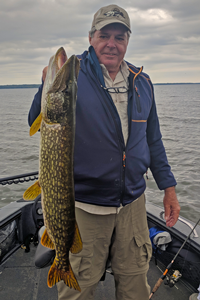 The fall session of Fun with Dick and Paul, MMXVIII has concluded, illustrating that if you want to discover how fast time passes, just go fishing for a week.
The fall session of Fun with Dick and Paul, MMXVIII has concluded, illustrating that if you want to discover how fast time passes, just go fishing for a week.
The week was a memorable one, featuring great weather and lots of action, even though not a lot of it was provided by walleyes. For one reason or another, crappie, perch and pike were more than easy to come by; walleyes came only a few at a time.
There have been times when I could speculate the reasons for fish behavior and come up with a reasonable explanation why they do what they do. This week though, I’m not that smart. We fished shallow water, deep water and mid-range water depths too. We fished on both large lakes and small lakes using a variety of proven presentations. In every case, we caught fish, but not very many of those fish ever came on any one presentation.
Take yesterday for example. Paul had the first known walleye strike of the morning while he was fishing with a jig and minnow along the breakline at a depth of 15 feet. Then I bagged a keeper size walleye by wiggle worming along the weeds in shallower water, about 8 feet deep.
After that, we landed at least a dozen pike before moving to a different area, where the next walleye strike came on my night crawler/spinner combo while we were bottom bouncing on the deep breakline in 30 feet of water. After that plan fizzled out, we moved again and started spinning the weed line where we caught at least another dozen pike before bagging one more keeper walleye.
We moved again, this time fishing a small, weedy point where wiggle worming in 12 feet of water produced a keeper walleye for Paul and a few more missed strikes.
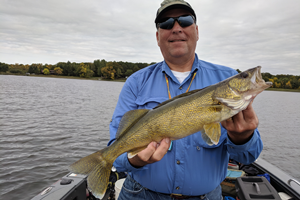 You get the idea, we were trying to be creative and not get hung up on any one idea. It was just hard to figure out a pattern that was repeatable.
You get the idea, we were trying to be creative and not get hung up on any one idea. It was just hard to figure out a pattern that was repeatable.
I guess maybe the combination of un-settled weather and the walleye’s natural migratory tendencies have the system shook up right now. As surface temperatures continue to decline, more fish will show up along shoreline points and breaks, making both location and presentation more predictable.
In the meantime, I can count myself lucky that I’m fishing with folks who appreciate catching a broad range of fish species. I’ve experienced more than my fair share of frustrations trying to deliver a good performance on a “walleye or die” mission at times when walleyes weren’t too cooperative. It’s nice for me to know that won’t be a huge problem this week and who knows; they could turn on any day now.
Before I go, congratulations to my friends Sean Colter and Dave Hernesman are in order. They teamed up to win the MWC Walleye Tournament on Cass Lake over the weekend.
Winning $12,000.00 for fishing a tournament sounds pretty good, but I happen to know how many hours these two have spent fishing on that lake and believe me; they have earned every nickel.
Seeing numerous fish and catching a respectable bag of walleyes while we were fishing on Cass Lake last weekend, I suspected that these pros would catch quite a few fish. From the looks of the leader board, they did, fishing on Cass and its connected waters yielded 121 total limits of 5 walleye out of a potential 160. That means over 75% of the teams managed to weigh in tournament limits over the two day event. Additionally, there were only 3 teams that came to the weigh in without bagging a walleye, less than 2% of the entrants.
With most entrants catching fish, the pressure to find a couple of big fish is intensified. Nobody can win by catching limits of “eaters”. Fishing on Cass and finding numbers of larger fish is what separates the men from the boys and it’s why all of those hours on the lake paid off for Colter and Hernesman; they’ve been doing more than a little bit of homework. ![]() - Jeff Sundin 218-245-9858 or EMAIL HB
- Jeff Sundin 218-245-9858 or EMAIL HB
 Jeff Sundin Fishing Report September 16, 2018 "Fun With Perch for Dick and Paul"
Jeff Sundin Fishing Report September 16, 2018 "Fun With Perch for Dick and Paul"
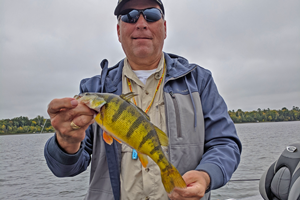 I've been behind the curve with reports about "The fall session of Fun with Dick and Paul, MMXVIII".
I've been behind the curve with reports about "The fall session of Fun with Dick and Paul, MMXVIII".
On one hand, it’s been a busy week and on the other, there haven’t been many new developments in terms of how, where or what we’ve been doing on the lakes. For the most part, everything we’ve done has been covered numerous times in recent reports.
Unlike their June trip when Lake Winnibigoshish was on fire for walleye fishing, pursuit of the Sander vitreus during this fall trip has been labor intensive. Crappie, Northern Pike and a smattering of perch had kept us occupied reasonably well, but going into day 4 on Saturday, I really felt like it was high time to find something special for the crew.
Finding a good “Perch Hole” had moved to the top of my priority list because perch have always been crowd pleaser for this crew. Not just because Dick and Paul’s wives both enjoy receiving the delicious fillets, but also because they provide lots of action; when I do my job right.
There’s one thing I’ve learned about perch, they almost always enter into their fall feeding patterns a week or two before the walleye do. When water temperatures settle into the mid 60 degree neighborhood, they will feed at the drop of a hat as long as the weather conditions are good.
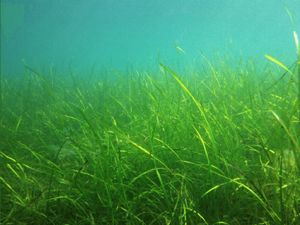 Crawfish are one staple food source for perch and so are young, minnow size perch. So places that provide good habitat for crawdads like clam beds or stretches of small rock or gravel and areas will usually be good. Low-lying weeds provide cover for young of the year perch minnows and these, especially lately, have been holding most of the perch that I know about.
Crawfish are one staple food source for perch and so are young, minnow size perch. So places that provide good habitat for crawdads like clam beds or stretches of small rock or gravel and areas will usually be good. Low-lying weeds provide cover for young of the year perch minnows and these, especially lately, have been holding most of the perch that I know about.
I call it eelgrass, but this may not be the precise scientific identification. It rarely grows more than a few feet above the bottom and on the screen of my Humminbird; its appearance is that of a heavy shag carpet. No matter what it’s called, this “fuzzy stuff”, especially when it’s located near clam beds or gravel bars is prime habitat for perch.
Admittedly, conditions were ideal on Saturday, the sky was dark grey, there was a light chop on the water and the surface temperature was 66 degrees. Perch may have been active in a variety of other places too. But when I drove the crew to one of my favorite patches of “fuzzy stuff”, it seemed like the epicenter of the perch world. In fact, after a 10 or 15 minute drift to search for the sweet spot, we found enough fish to keep us busy for most of the rest of the day.
Lindy Live Bait Jigs tipped with above average size Fatheads was our best presentation. The fish were active today so for us, the 1/16 ounce size was better for casting into the weeds; they settle softly into the grass and don’t get hung up a lot. Sometimes fishing vertically, using a heavier jig might make more sense though; the extra weight allows you to hold the lure steady, closer to the bottom. On a sunny day, the slower vertical presentation will often allow less aggressive fish a few extra seconds to find the bait and strike it.
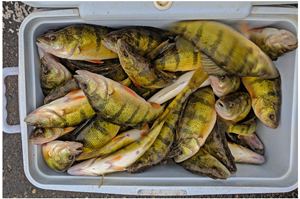 Pike, walleye and rock bass were present, but hardly paid any attention to the jig and minnow presentation. But when we experimented with spinners, the other species responded more positively. I’d have to re-run the entire trip to know how it would have turned out, but it’s possible that we could have still captured limits of perch, and had a mixed bag of walleye and pike to boot. As it was, we had more than enough fish to clean at the end of the trip, so I’m not disappointed with the way we approached it.
Pike, walleye and rock bass were present, but hardly paid any attention to the jig and minnow presentation. But when we experimented with spinners, the other species responded more positively. I’d have to re-run the entire trip to know how it would have turned out, but it’s possible that we could have still captured limits of perch, and had a mixed bag of walleye and pike to boot. As it was, we had more than enough fish to clean at the end of the trip, so I’m not disappointed with the way we approached it.
The size of our fish was good; we set our bar at 10 inches and were able to bag limits of fish from 10 to 11 inches long. There were a handful of fish over 11 inches, but not many.
I know what you’re thinking, I told you how we did it but I forgot to mention where we were. That’s because it doesn’t matter, if you’re on any one of the major perch fisheries in the area, this pattern will work. In fact, I believe this to be one of the half dozen most reliable fall patterns that I know about.
If you’re thinking about catching some perch and you’re willing to snoop around a little bit, you should be able to drum up some action over the next couple of weeks. ![]() - Jeff Sundin 218-245-9858 or EMAIL
- Jeff Sundin 218-245-9858 or EMAIL
 Jeff Sundin Fishing Report September 14, 2018 "How Long Will Weed Patterns Continue To Produce Fish?"
Jeff Sundin Fishing Report September 14, 2018 "How Long Will Weed Patterns Continue To Produce Fish?"
Here we go again, its mid-September and instead of bundling up to ward off cold, frosty weather, I'm still wearing shorts and short sleeve shirts to work. In fact, if it hadn’t been for the strong wind that blew during the first half of the day Thursday, it might have even felt hot on the water.
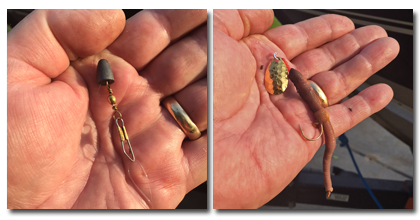 Those gusty winds produced whitecaps and strong current in the shallow water, but they did not bring about any significant change in the surface water temperature. At 67.3 degrees, conditions on Bowstring Lake were nearly identical to those that we found there last Tuesday. However, one noticeable effect of the churning water was the volume of uprooted vegetation floating on the lakes surface.
Those gusty winds produced whitecaps and strong current in the shallow water, but they did not bring about any significant change in the surface water temperature. At 67.3 degrees, conditions on Bowstring Lake were nearly identical to those that we found there last Tuesday. However, one noticeable effect of the churning water was the volume of uprooted vegetation floating on the lakes surface.
After spending another day watching masses of weeds float past my Pro V, I found myself wondering how many weeds have disappeared from lakes like Bowstring which have numerous shallow water flats. That’s because the presence of healthy vegetation will affect how long weedline fishing patterns will continue to produce fish.
It’s ironic how the timing of daily life works out because while I was pondering answers to that question, I received an email from my friend Erling Hommedahl who in preparation for his upcoming fishing trip, wrote;
“Hi Jeff, I just read your report about Joe and his buddies fishing with you; great Job.
We’re staying at Cut Foot Sioux Inn again this year and wonder if you would you please give us some ideas as what I should be picking up for jigs and spinners in the Lindy line? Color and weight would be helpful.”
Answering Erling’s question about spinners is directly related to my question about how long the weeds and weedline fishing patterns will continue to be productive. While I was thinking about addressing that, I recalled a similar theme of an article written last year about the late arrival of fall and how it affected fishing patterns.
I sifted through my archives, found the link to “October, The New September” and when I clicked on it, found myself looking at a photo taken last year of Erling’s gracious and lovely wife Karen; yes it’s a small world.
The upshot is that we do appear to be on a similar track this fall. Barring a major weather change, it does appear that weedline trolling patterns using spinners should continue to produce good results until the end of this month.
I remembered addressing a similar question about my selection of spinners that does include colors, sizes and how to rig them up. So instead of re-writing the answer let me refer you to this article >> “Rigging Spinners for Fishing Weed Walleyes”.
Regarding jig selection and sizes, I can usually cover most bases with a modest selection that includes some Lindy Jigs and some Lindy Live Bait Jigs. I use the live bait jigs for fishing with minnows and night crawlers. The Lindy Jigs feature longer hooks and barbed collars which makes them more useful when I’m using artificial action lures like YUM’s Pulse or Ribbon Tail.
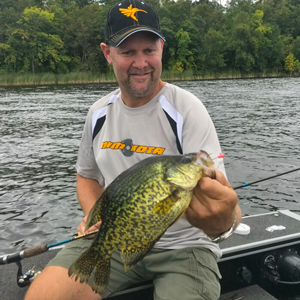 In either case, I carry a greater supply of the 1/8 ounce sizes, but also have a good selection of 1/16 ounce for shallow water and some ¼ ounce for deep water as well. I can’t afford to get caught short, so I have every color that’s available, but my short list of essential colors includes Blue/Glow, Black, Pink and Glow/Perch. You may have your own personal favorite, so go ahead and include a few of those too.
In either case, I carry a greater supply of the 1/8 ounce sizes, but also have a good selection of 1/16 ounce for shallow water and some ¼ ounce for deep water as well. I can’t afford to get caught short, so I have every color that’s available, but my short list of essential colors includes Blue/Glow, Black, Pink and Glow/Perch. You may have your own personal favorite, so go ahead and include a few of those too.
This should get you into the ball park, but if you have more specific questions, let me know. And by the way, bear in mind that there are bait and tackle shops that handle these items and they are located within easy reach of Cutfoot Sioux. So just in case there is one super-hot color, they will definitely be available when you get here.
While I was trolling the shallows on Thursday, my friends Steve Kusske and Jon Thelen were in the area crappie fishing.
The migration toward deeper water appears to be continuing and some of the fish are showing up over mid-lake basin areas rather than along steep breaklines and shoreline related structures. They fished in water depths of 25 to 28 feet, wherever schools of suspended fish could be located.
Jon was using a Lindy Live Bait Jig tipped with small minnows and suspended below a slip float. As you can see in the photo, there are fish of good quality showing up in the mix.
Fishing traffic is expected to be heavy this weekend and for many, crappies will be the primary species that they intend to pursue. Your strongest asset for this weekend will be creativity, there are fish located in a wide variety of locations and the anglers who manage to located un-tapped schools of fish will be the most productive. ![]() - Jeff Sundin 218-245-9858 or EMAIL
- Jeff Sundin 218-245-9858 or EMAIL
 Cutfoot Sioux, Bowen Lodge Fishing Report September 13, 2018
Cutfoot Sioux, Bowen Lodge Fishing Report September 13, 2018
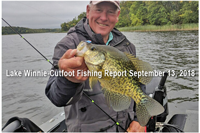 "It’s been a wild ride on the big lake this week, strong winds, combined with cooler water temperatures have forced a shift in location for baitfish and gamefish alike. Whitecaps turned some Cutfoot’s shallow weedy flats inside out too. Weed beds that were too thick to fish only a few weeks ago are thinning out and many of their former inhabitants are re-locating to deeper water.
"It’s been a wild ride on the big lake this week, strong winds, combined with cooler water temperatures have forced a shift in location for baitfish and gamefish alike. Whitecaps turned some Cutfoot’s shallow weedy flats inside out too. Weed beds that were too thick to fish only a few weeks ago are thinning out and many of their former inhabitants are re-locating to deeper water.
Surface water temperatures were roughly 67 degrees on Wednesday and are not likely to go anywhere except down from here. As the temperatures decline, feeding activity definitely increases and it won’t be long before conditions become ideal. Over the years, we have seen some of the best fall fishing occur when temperatures transition from the low sixties, down into the high fifty degree range.
Every season is different, but in 2017, that temperature range occurred during the last week of September, going into the first week of October. One of the area’s popular fishing guides ..." Read >> Bowen Lodge Fishing Report September 13, 2018
 Jeff Sundin Fishing Report September 12, 2018 "Watch Joe Pull A Walleye Out Of His Hat!"
Jeff Sundin Fishing Report September 12, 2018 "Watch Joe Pull A Walleye Out Of His Hat!"
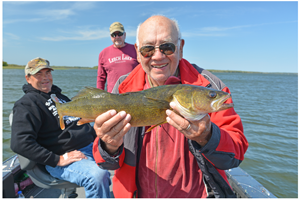 There are some seriously nice people in this world and Joe Stevens is one of them. He’s inquisitive, patient, warm hearted and has no agenda other than making people happy. In fact, he’s probably already made you happy and you never even knew it. That’s because many of the most popular magicians in the world have perfected their skills and learned how to make you believe the un-believable through his business, the Stevens Magic Emporium.
There are some seriously nice people in this world and Joe Stevens is one of them. He’s inquisitive, patient, warm hearted and has no agenda other than making people happy. In fact, he’s probably already made you happy and you never even knew it. That’s because many of the most popular magicians in the world have perfected their skills and learned how to make you believe the un-believable through his business, the Stevens Magic Emporium.
Every time I’ve ever fished with Joe, he has mentioned two of his very good friends Ralph Carlson and Brian Titus. Well known in the Grand Rapids area and expert fishermen in their own right, Ralph and Brian have taken Joe under their wings and shared many a fishing trip with them. Joe wanted to do something special to return their favors, so he came up with the idea of hiring me to take them all fishing.
I’ve known both Ralph and Brian for a long time, but I doubt that between us, we shared enough conversation to fill a single notebook page. What I did know was that Joe respects both of them a lot and considers them to be highly skilled fishermen. That’s why I was a little bit intimidated, what would happen if these guys fished with me on a day that I just couldn’t get it right? The last thing I wanted to do was to fall short of fulfilling Joe’s expectations.
I got over those fears within 2 minutes of meeting them at Fred’s Bait when a customer tipped me off that I had a flat tire on my boat trailer. Complicated by a lack of certain correctly sized tools, the delay took longer than it should have. But these guys jumped in and helped out and demonstrated lots of patience and understanding.
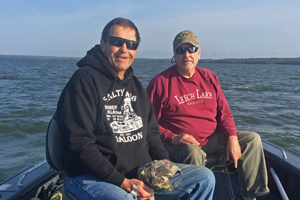 Before long, we were back on the road, headed for Bowstring Lake and the promise of a mixed bag of crappie, walleye and perch; hopefully in quantities large enough to keep the crew interested.
Before long, we were back on the road, headed for Bowstring Lake and the promise of a mixed bag of crappie, walleye and perch; hopefully in quantities large enough to keep the crew interested.
For me, the fish have been in a different location every time I’ve been on that lake. So I let everybody know ahead of time that it might take a while before I found something to do. But luckily, this was the one day that the fish, crappies in particular, were in the same place that I’d found them a day earlier.
The fish were still holding in a stretch of shallow weeds where we’d trolled through them using spinners on Monday. They were active and we managed to sort out 11 keepers before the wind became so strong that I could no longer maintain control. From that point on, we would never locate another catchable crappie. The wind may have been too strong to allow effective presentation or maybe they have already begun moving toward deeper water; I won’t know until conditions settle down again.
It may have cut short our crappie fishing, but the wind was a blessing in another way. The strong current produced by heavy seas did shake up enough walleyes, perch and pike to make the day interesting. As you’d expect on Bowstring, pike were the most active, but there was an above average perch bite going on too. The walleyes were semi-cooperative and I think we had 8 keeper walleye, maybe it was 7. As a bonus, Joe showed us his own magic trick too. "Nothing up my sleeve, Joe said and added now ladies and gentlemen, watch me pull a walleye out of my hat!" Drum roll ... and voilà, Joe caught and released a nice 25-1/2 incher.
Thanks to the strong and gusty winds, there was scarcely a spot on the lake that wasn’t kept churning by whitecaps. As a result, weeds were uprooted and floating loose everywhere on the surface. There was so much current that the shallow water is very likely to have been “turned over”. The 67.9 degree water temperature is probably uniform from the surface to the bottom, at least in areas shallower than 15 feet or so. These "mini-turnovers
This was a day when I had a lot of ideas, but couldn’t do much about them. Jigging entered my mind more than once, but the Little Joes tipped with minnows were producing fish, so I never felt the need for making a change. If there was any magic on my part at all, it was keeping the Pro V on a course steady enough to provide opportunities for the crew.
Aside from the wind, it was a great day and Joe got his wish, he made his friends happy. We had plenty of action, brought home some food for the family, and I made some new friends to boot. How can you do better than that? ![]() - Jeff Sundin 218-245-9858 or EMAIL
- Jeff Sundin 218-245-9858 or EMAIL
 September 12, 2018 "MARATHON MAN ON A MISSION" Kolodzinski, Guinness World Record Holder Attempts To Break His Own Record Today
September 12, 2018 "MARATHON MAN ON A MISSION" Kolodzinski, Guinness World Record Holder Attempts To Break His Own Record Today
 Canton, Ill. — Jeff Kolodzinski is a man on a mission — a Marathon Man out to break a record he already holds. On September 11 and 12, 2018, at Giant Goose Ranch in Canton, Illinois, he will attempt to catch more than 2,143 fish on hook and line to break his own world record set in 2011.
Canton, Ill. — Jeff Kolodzinski is a man on a mission — a Marathon Man out to break a record he already holds. On September 11 and 12, 2018, at Giant Goose Ranch in Canton, Illinois, he will attempt to catch more than 2,143 fish on hook and line to break his own world record set in 2011.
But Kolodzinski is not doing it for a spot in the record books. He’s doing it to introduce people and families to fishing and to increase awareness and financial support for the Fishing For Life, a non-profit, tax exempt charitable organization whose Next GEN program finds mentors for children of families in need.
A special focus within the program, serves families of our veterans who have lost loved ones while serving our nation. It’s important to me to remember those who have sacrificed for our nation and 9/11 is a day that we can honor those who have given all and shine a light on those still serving.
"Not only is Kolodzinski the current world record holder for fish caught in a 24-hour period, but he also represented the United States seven times in international competition at the World Championship of ..." Learn More and Watch Live Video Feed >> Kolodzinski, Guinness World Record Holder Attempts To Break His Own Record
 Lake of the Woods, LOW Tourism September 11, 2018
Lake of the Woods, LOW Tourism September 11, 2018
 "Incredible week of walleye fishing. Very strong walleye fishing continues as we transition into fall.
"Incredible week of walleye fishing. Very strong walleye fishing continues as we transition into fall.
Limits of walleyes with big fish mixed in has been the norm. Crankbaits and still spinners with crawlers in main basin successful. 32-34 feet of water in Big Traverse Bay holding big numbers of walleyes and there are fish being caught all around Big Traverse Bay. Walleyes being caught as shallow as 2' and everywhere in between.
Shiners showing up at mouth of Rainy River with some running up the Rainy River. On the Rainy River, sturgeon fishing "keep season" continues until Sept 30. Some walleyes entering river after shiners which are starting to come in. Some reports of walleyes being caught as shiners trickle in. Fall is a productive and beautiful time on the Rainy River.
Up at the NW Angle, strong numbers of walleyes being caught on mud flats with bottom bouncer with crawler harness or on crankbaits on both sides of the border. 22 - 27 feet of water is a good start. Perch schooling on top of reefs. Muskie activity picking up. Next full moon, Sep 24. Sep/Oct Crappie anglers are producing nice black slabs." – Lake of the Woods Tourism, (800) 382-FISH
 Lake of the Woods, Border View Lodge September 11, 2018
Lake of the Woods, Border View Lodge September 11, 2018
"The Minnesota Tournament Trail is gearing up for their Championship event later this week! A new Skeeter boat and motor package is at stake! We wish good luck to all the competitors!
The Walleye Master Guides have started to mix in more jigging this past week. We continue to see large schools of bait and fish outside the Lighthouse Gap. While most of the angling has been drifting with spinners we have also been doing some vertical jigging with frozen minnows. We continue to have great success with catches of eater size, big and little Walleye. We have been spending more time in Big Traverse Bay this past week. The water temps continue to cool down and we have had some Shiner activity in the river.
Temperatures from the 50’s to 70’s are forecasted for the week ahead. Fall is in the air and the colors are starting to change.
We are booking for winter, give us a call to lock in your dates!" - 1-800-776-3474 Border View Lodge
 Jeff Sundin Fishing Report September 10, 2018 "Respecting the Respectable; Our Day on Cass Lake"
Jeff Sundin Fishing Report September 10, 2018 "Respecting the Respectable; Our Day on Cass Lake"
On my way to meet my fishing customers on Cass Lake, I stopped at Fred’s Bait in Deer River to get supplies for the day. Curious about whether or not there have been any reports, I asked Bill Powell what he’s heard. “Anglers that are over there pre-fishing for next week’s tournament are getting quite a few fish, but it doesn’t sound like many of them are getting big fish. Reports are that most folks are doing their best work using night crawlers”, Bill said.
I took Bills advice and bought some extra worms, but I know that the fish on Cass Lake can be fickle. Because I’ve learned from past mistakes, I wanted to make sure that bait wise, my bases were covered. So I added a pint of Large Fatheads, a couple of dozen Redtail Chubs and a handful of jigging baits. I already had packed what was left of my private stash of decent leeches that I’d been keeping on hand since mid-august.
When I met Scott and Mike at the landing, the water level was a little low; down about a foot from what I saw the last time I fished there. The surface temperature had dropped too, now tickling the 66 degree mark on my thermometer. Conditions had changed just enough to expect that fishing patterns would have moved toward fall presentations more so than summer ones.
I told the crew to plan on fishing with almost everything in the arsenal; spinners, Lindy Rigs, jigging bait and bottom bouncers. The funny thing is that we wound up doing it all and all of them worked; a little bit.
We picked up a few fish trolling spinners over a shoreline point at about 14 feet of water. There were a lot more fish on the screen of my Humminbird than there were at the end of our fishing lines. I had to see at least a half dozen fish before anyone got a strike, so we left the area in search of fish that were more aggressive. From that point on, we didn’t return to shallow water because we saw numerous fish in a variety of deep water locations. For me, 31 to 35 feet of water was the “magic” number.
If you’ve read many of my reports, then you already know that I don’t like fishing in water depths over 30 feet. In this case though we had a goal of getting fish for the frying pan and we were willing to accept whichever fish the lake gave us. We did not bag a 2-man limit for the crew, but we came close, keeping 10 walleyes total. If we’d bagged 12 fish, then we would have returned to shallow water to drum up some perch or maybe pike. There was one fish in our larder that was pretty small, but kept because of being caught so deep. Luckily, the rest of the fish were of respectable size, ranging from 14 to 19 inches.
I was impressed by both the number of fish that were visible on my electronics and the variety of locations where could find them. I was not impressed by their attitude though, seeing fish and getting them to strike were two distinctly different experiences. I’d estimate seeing a couple of hundred fish on my Humminbird which yielded maybe 20 strikes total.
We caught 3 fish on the Redtails, 3 fish on spinners tipped with night crawlers and 4 fish on leeches. Ironically, the one bait that was reported to be “best”, night crawlers did not yield any fish from the deep water. Jigging baits hardly received a fair test, but we did not land a fish using them.
Conditions were windy; there were whitecaps on top of 2 foot rollers, so boat control was a chore. We definitely got the most strikes in areas where I did my best job of controlling our boat speed, so it’s possible that we’d have a caught a few extra fish under slightly more manageable circumstances.
All things considered, it was a good day. The crew was in good spirits, we had respectable catch and a nice shoreline dinner at the end of our fishing day. Even if the action isn’t “wide open”, I’m guessing that most folks who visit the lake this week will catch at least some fish. ![]() - Jeff Sundin 218-245-9858 or EMAIL
- Jeff Sundin 218-245-9858 or EMAIL
 Jeff Sundin Fishing Report September 9, 2018 "Late Start To Early Fall Fishing Patterns"
Jeff Sundin Fishing Report September 9, 2018 "Late Start To Early Fall Fishing Patterns"
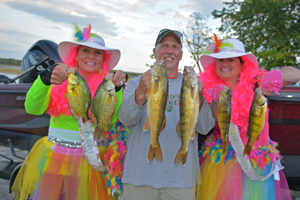 I want to say that fall weather has produced hot fishing action and that the fall bite has begun, I really do. But, surface water temperatures have been stubborn over the past few days; I’ve seen readings as warm as 70 degrees, with the coolest personal observation of 67 degrees. With the slow cool-down, the feeding preferences of fish in the cooler water lakes are changing a little bit. But in others, there’s no signal that fall fishing patterns have kicked in at all.
I want to say that fall weather has produced hot fishing action and that the fall bite has begun, I really do. But, surface water temperatures have been stubborn over the past few days; I’ve seen readings as warm as 70 degrees, with the coolest personal observation of 67 degrees. With the slow cool-down, the feeding preferences of fish in the cooler water lakes are changing a little bit. But in others, there’s no signal that fall fishing patterns have kicked in at all.
The most notable departure from a “normal” fall fishing trip for the VA Nurse crew was the complete absence of any jigging presentations that we’ve relied on to catch fish in the past. Spinners tipped with fathead minnows replaced jigging for walleyes and while Crappies were present in deeper water, those fish showed absolutely no interest in striking. But there are still lots of fish in the weeds and for us; the shallow water fish were more than cooperative.
With these warmer than average water temperatures one would think it best to get an early start in the morning. But for us, that didn’t work, the fish showed a strong preference for the warmer portion of the afternoon and early evening.
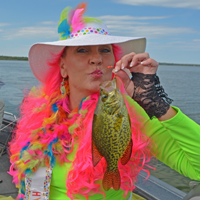 On day 1, the early morning bite was slow for Phil, Mark and Joyce, but improved steadily as the sun got higher in the sky. Later, the Luscious Sisters were kept extremely busy all afternoon long. Pike, crappie and perch kept them occupied while Phil added a few extra walleyes to the larder.
On day 1, the early morning bite was slow for Phil, Mark and Joyce, but improved steadily as the sun got higher in the sky. Later, the Luscious Sisters were kept extremely busy all afternoon long. Pike, crappie and perch kept them occupied while Phil added a few extra walleyes to the larder.
The fishing scenario played out the same way on day 2, the morning crew worked hard for an occasional strike, while the afternoon crew enjoyed almost non-stop afternoon action.
If there was a single event that triggered the fish to move during better during the afternoons, it was the wind. On both days, calm conditions prevailed during the morning, while afternoon breezes churned up a light chop. Wind is a major factor during the fall, especially during these early days. I am fairly sure that with stronger winds in the morning, fishing action would have been more uniform throughout the day.
Saying that this was a mixed bag weekend is an understatement. There were pike, perch, crappie and walleye all holding in the same areas; we never knew what the next bite would be. Except for one crappie that Mark caught in 23 feet of water, all of the fish we caught came from water depths of 4 to 8 feet. If there was "a trick" to singling out crappies and walleye, it was to stay shallow. Fishing above the sharp breakline where norther pike were holding seemed to tip the odds against the pike.
 Like I said, jig and minnow fishing presentations have not become part of my daily routine so far. As much as I want to be fishing with them, the fish keep showing a preference for trolling presentations. For me, the standard Little Joe Spinner tipped with minnows has worked very well. For others, crankbaits are producing fish too.
Like I said, jig and minnow fishing presentations have not become part of my daily routine so far. As much as I want to be fishing with them, the fish keep showing a preference for trolling presentations. For me, the standard Little Joe Spinner tipped with minnows has worked very well. For others, crankbaits are producing fish too.
It’s only a matter of time before the jig and minnow will become the go to presentation. So I do have the jigging rods ready and I am carrying a supply of larger fatheads every day because I don’t want to get caught short suited on the day that feeding preferences change.
With all of that extra bait to take care of, I’ve added an extra bit of equipment to my arsenal. For $90.00, I picked up a solar power kit that comes complete with the solar panel, a 12 volt battery charger and all of the wiring. Connected to a standard 12 volt marine battery, it keeps the 12 aerator in my pickup running at all times.
With the rising cost of bait, keeping my minnows alive legally is a really high priority. If $90 is all it takes to prevent any bait loss due to dying batteries, then this is a no-brainer. I’ll be keeping close watch over how well the improved system works and I promise to provide a review after I’ve had some time to assess how well it works. ![]() - Jeff Sundin 218-245-9858 or EMAIL
- Jeff Sundin 218-245-9858 or EMAIL
 September 7, 2018 - "Tugsten Ice Lures, Select Colors and Sizes For Open Water"
September 7, 2018 - "Tugsten Ice Lures, Select Colors and Sizes For Open Water"
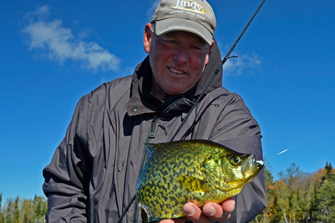 Q) On September 6, 2018 Dave Heck Wrote; “You wrote about the Lindy tungsten ice worm, bug and toad today and I was wondering if you would share with me the colors you find work the best? I like to have 4 to 5 of each color on hand and it starts to add up quickly when you're trying to cover all the sizes and colors. I hope you understand. Thanks Dave
Q) On September 6, 2018 Dave Heck Wrote; “You wrote about the Lindy tungsten ice worm, bug and toad today and I was wondering if you would share with me the colors you find work the best? I like to have 4 to 5 of each color on hand and it starts to add up quickly when you're trying to cover all the sizes and colors. I hope you understand. Thanks Dave
A) Dave, Yes I do understand; nobody likes to stock up on fishing tackle that won’t serve the end goal of catching fish.
I have to be a little more prepared than most folks when it comes to the variety and amount of lures that I have on hand, so I have at least a couple of most colors and sizes. That said, I do have a short list of favorite colors and sizes that work very well for me across a wide variety of fishing situations.
One caveat though, there I have fished certain lakes that seem to have their own “favorite colors” and there’s no way that I can know all of them. So unless by coincidence, we both happen to fish the same waters, advice from local experts about your favorite lakes will also be helpful in fine-tuning your own short list of colors and sizes.
The Tungsten Ice Worm is my #1 go to lure for suspended fall crappies and there are three colors that I consider indispensable. Pink/Glow, Pink/Chartreuse Yellow and Black/Chartreuse Green are available in my gear bag at all times. If I had to limit myself to only one hook size, it would be the #6.
The Tungsten Toad gets the nod when I’m fishing for suspended sunfish or when crappies are sluggish and show a preference for smaller size offerings. This lure is extremely versatile and I have every size and color on hand at all times. But for me, Brown/Orange, Black/Chartreuse Green, Red/Glow and Pink/Yellow Chartreuse are absolutely essential colors.
When the lakes freeze, both the Tungsten Bug and Tungsten Fat Boy get added to the arsenal as well. Later, when the open water fishing season has passed, I’ll outline some of my preferred choices for the ice fishing season. ..." Read >> Tugsten Ice Lures, Select Colors and Sizes For Open Water
 Jeff Sundin Fishing Report September 6, 2018 "Early Fall Panfish Migrations, Understanding the Understandable"
Jeff Sundin Fishing Report September 6, 2018 "Early Fall Panfish Migrations, Understanding the Understandable"
At the fish cleaning shack yesterday afternoon, a 3 way conversation between my customer, me and an acquaintance of his went something like this; “We had trouble finding the bluegills today, but we got into some perch” Clem said.
I replied, “We didn’t have any trouble finding them, but they were finicky and tricky to hook. I’ll bet you must have tried fishing for them in the weeds today?” Clem replied; “yes, that’s where we found them yesterday, but they were not there today.”
That’s how fast it happens, one day they’re in there and the next day they are not. Fish that have inhabited the weedline for the better part of this past summer, made a mad dash for deeper water on the heels of a cold front that blew in overnight Tuesday.
The only reason I knew that is because like Clem, I had already taken Steve and Al into the weeds, searching for panfish myself. When we didn’t find them there, I reasoned that maybe the weather change was enough to force some of the fish away from the shoreline and into open water. We checked a few spots and discovered that to a certain extent, my hunch was right.
I wish I could tell you that we found huge schools of super-aggressive sunfish, but that wasn’t how it happened. We found small, isolated packs of fish that were tightly schooled and they were extremely fussy about their diets. They were aggressive enough to strike our lures, but sinking the hooks into their mouths was challenging to say the least.
Crappies that were located along the weedlines made a move too and the only reason that we found them was by paying attention to some little smudges on the screen of my Humminbird. Instead of “stacking up” and forming easily identifiable suspended schools, these crappies spread out horizontally along the bottom. On my Helix, they looked like little bumps on the bottom and could easily have been mistaken for rocks, stumps of low-lying patches of vegetation.
Side imaging is often touted as a way to find fish, structure and submerged objects. But in this particular case, I used my side imaging to rule out that any of those elements existed below us. After I examined the bottom and saw no sign structure, I was convinced that the bumpy smudges on my screen were actually fish.
We trolled across the flat using Little Joes and minnows and just like magic, crappies started coming into the boat. I wish that I could tell you that we found huge schools of super-sized slabs, but that’s not how it happened. The fish were active, but small and we had to work at sorting through them to wind up with a dozen keepers. For us, that meant fish that each fish was measured and crossed over the 10 inch mark. If we’d been willing to keep 9-1/2 inch fish, a two man limit could have been easily produced. Hopefully some of those small fish will survive the winter and provide a little action next year.
The surface water temperature, 69 degrees, didn’t seem all that cold compared to what it was before Labor Day, but apparently it was enough of a change to trigger the movements. The outside temperature is 39 degrees right now, so I’m guessing that I’ll see further evidence of panfish migrations today.
Just a reminder, the fish that I’ve been targeting may not be doing the same thing as the fish in your lake. Migrations toward fall locations begin earlier on shallow water lakes than they do in deep water. And as long as there are green weeds, some of the fish will continue to use them. For now, it would be understandable that multiple patterns could be going on at the same time, on the same lake.
The upshot of today’s report should be that if you’ve been successful recently, show up at your honey hole and find out that the fish aren’t there; don’t assume that it’s because they’re not biting. Instead, spend some time looking around to see if you can figure out where they went; it could help turn your trip into a good one. ![]() - Jeff Sundin 218-245-9858 or EMAIL
- Jeff Sundin 218-245-9858 or EMAIL
 Wired2Fish September 4, 2018 "How to Use Side Imaging to Find Hidden Spots"
Wired2Fish September 4, 2018 "How to Use Side Imaging to Find Hidden Spots"
 "Side imaging sonar reveals an entirely new underwater world to anglers interested in learning the technology. It produces highly detailed readouts of the water column and bottoms off both sides of the boat; this has some major benefits, one of which being discovering sleeper or hidden spots missed by most anglers.
"Side imaging sonar reveals an entirely new underwater world to anglers interested in learning the technology. It produces highly detailed readouts of the water column and bottoms off both sides of the boat; this has some major benefits, one of which being discovering sleeper or hidden spots missed by most anglers.
Jeff "Kolo" Kolodzinski demonstrates this perfectly. While driving to one of his "known" spots, side imaging reads a bottom composition change - it's a hard spot covered with fist-sized rocks and some larger boulders mixed in. Of note, there's no appreciable change in depth, so mapping doesn't give it away.
Conventional 2D sonar or Down Imaging could reveal the spot but requires driving over the top to discover it and with less detail. Humminbird's MEGA Side Imaging leaves little to the imagination." View Video >> How to Use Side Imaging to Find Hidden Spots
 Jeff Sundin Fishing Report September 5, 2018 "Panfish Time?"
Jeff Sundin Fishing Report September 5, 2018 "Panfish Time?"
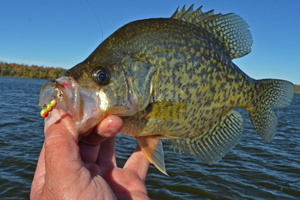 So far, surface water temperatures have shown resistance to falling below the 68 to 69 degree range. But frost is mentioned in the forecast for tonight and that could easily send surface temps down another few degrees.
So far, surface water temperatures have shown resistance to falling below the 68 to 69 degree range. But frost is mentioned in the forecast for tonight and that could easily send surface temps down another few degrees.
For now, weed growth remains healthy in most areas too, but cooler temperatures and shorter days are chipping away at some varieties of vegetation. As weeds begin to die off, small fish and minnows will be forced out of the shallowest portions of the weed flats. As the food supplies shift toward deeper weed edges and steep shoreline breaks, panfish along with predators like pike and walleye will begin showing up to capitalize on the feeding opportunity.
The changes in fish location will also force changes in presentation. Trolling the shallow weeds with spinners has been fun, in fact that’s how we fished on Tuesday and it was still working. But sifting through the archived fishing reports from last September, I found that the timing of the cooler weather’s arrival is very similar to that of the 2017 season. When the temperatures dropped, crappies began showing up along steeper breaklines and became the focus of my fishing during the transition.
That’s why I’m making sure that I have the ultra-light fishing rods loaded into the boat today. So too will be a supply of small plastic tails, crappie minnows and my ice fishing tackle. Fishing with larger jigs works fine most of the time, but when the going gets tough, it can be easier to trick panfish with smaller offerings. Since tungsten arrived on the ice fishing scene, finding small, but heavy lures has gotten easier and last winter, my favorite open water ice fishing lure, the Lindy Ice Worm became available in tungsten as well.
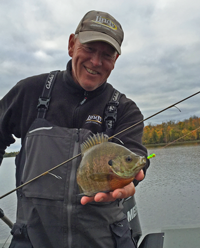 If you’ve spent time fishing for suspended panfish in open water, then you already know how important depth control is. Place your lure a little too low and the fish can’t find it, a little too high and they won’t come up to strike it. If the lure you’re using is too light, then it’s hard to figure out where it is in the water column. That’s why heavy, but small lures are so important; they help you stay in contact with your lure and that allows you to keep your lure in contact with the fish.
If you’ve spent time fishing for suspended panfish in open water, then you already know how important depth control is. Place your lure a little too low and the fish can’t find it, a little too high and they won’t come up to strike it. If the lure you’re using is too light, then it’s hard to figure out where it is in the water column. That’s why heavy, but small lures are so important; they help you stay in contact with your lure and that allows you to keep your lure in contact with the fish.
Not only do the heavier tungsten lures solve the problem of depth control, but they also make it easier to detect strikes. A heavy lure helps keep the slack out of your fishing line so whenever a fish touches your lure you can both feel the strike and see it on the tip of your rod as well.
One reason that I go with the Ice Worm is that they are small enough to be considered small, but also large enough to have hooks that can accommodate a variety of dressings. If I want to use them with a crappie minnow I can, but I can also use them with waxworms, and/or artificial tails. I use the #6 hooks most of the time, but for days when the fish show a preference for smaller sizes, I drop down to the #8 and sometimes even the #10 size.
When fish show a preference for really small lures, then I switch to either the Tungsten Bug or the Tungsten Toad. These are most frequently paired with waxworms, but will accommodate some small artificial tails too.
Because they may not be on the store shelves this early, I stocked up on ice jigs last winter when they were easy to find. But they are available on the internet and that’s the reason I’m mentioning the ice jigs now. You can get your hands on them soon enough to take advantage of panfish bites that are just beginning. Lurenet offers a wide variety of fishing products and they have the tungsten lineup, so does the Lindy Fishing Tackle site; here are links to the Tungsten Ice Worm on both of them. >> Lindy Fishing Tackle >> Lurenet ![]() - Jeff Sundin 218-245-9858 or EMAIL
- Jeff Sundin 218-245-9858 or EMAIL
 Lake of the Woods, LOW Tourism September 4, 2018
Lake of the Woods, LOW Tourism September 4, 2018
 "Wow, what a great week of walleye fishing. With the NWT (National Walleye Tour) anglers prefishing for this week's championship, a lot of big fish pics on web. A mix of spinners & crawlers and crankbaits in main basin successful. 32-34 feet of water in Big Traverse Bay holding big numbers of walleyes. Best colors, brand and size varies based on angler.
"Wow, what a great week of walleye fishing. With the NWT (National Walleye Tour) anglers prefishing for this week's championship, a lot of big fish pics on web. A mix of spinners & crawlers and crankbaits in main basin successful. 32-34 feet of water in Big Traverse Bay holding big numbers of walleyes. Best colors, brand and size varies based on angler.
Shiners showing up at mouth of Rainy River with some running up the Rainy River. Fish being caught along south shore. On the Rainy River, sturgeon fishing "keep season" is open until Sept 30. Some walleyes entering river after shiners which are starting to come in. Last year, mid - late September started some excellent walleye fishing in river. This year, time will tell, but things are starting.
Up at the NW Angle... Strong numbers of walleyes being caught on mud flats with bottom bouncer / crawler harness on both sides of the border. Larger fish south of Garden Island in basin. Perch schooling on top of reefs. Nice muskies boated this week with increased activity as fall approaches. Next full moon, Sep 24. Crappie fishing picking up as traditionally does in September & October." – Lake of the Woods Tourism, (800) 382-FISH
 Lake of the Woods, Border View Lodge September 4, 2018
Lake of the Woods, Border View Lodge September 4, 2018
"We are starting to see large schools of bait outside the Lighthouse Gap, as well as swimming along the docks in the river. The Fall trends are starting.
Our guides are still covering many areas of the lake and mixing in different methods. Drifting with crawlers has been a steady go to this past week. We have sampled some anchoring and jigging without great success. Down rigging is still steady.
Cooler temps and shorter daylight hours are here. This week shows highs into the 70’s and low’s in the 40’s.
Fall Special rates start soon, do you have your trip booked already? Give us a call and we can check availability!" - 1-800-776-3474 Border View Lodge
 Jeff Sundin Fishing Report September 3, 2018 "Enjoying the Enjoyable With Family and Friends"
Jeff Sundin Fishing Report September 3, 2018 "Enjoying the Enjoyable With Family and Friends"
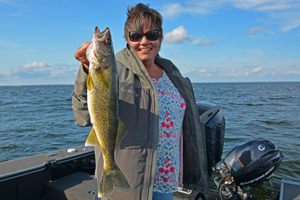 You know the old expression; "if you want something done right, you better do it yourself." I dare say that over the past 33 years, I've taken that advice to a whole new level. But, Sooner or later, it had to happen; there was no way that I could spend my entire life without anybody ever putting a leech on my hook for me.
You know the old expression; "if you want something done right, you better do it yourself." I dare say that over the past 33 years, I've taken that advice to a whole new level. But, Sooner or later, it had to happen; there was no way that I could spend my entire life without anybody ever putting a leech on my hook for me.
That’s right, mark your calendar, September 2, 2018, Jeff Sundin sat in a boat and watched somebody bait his hook!
It all started when my friend and frequent fishing partner Jon Thelen invited the Hippie Chick and me to spend an afternoon at the lake with him and his wife Amy. The four of us were scheduled to relax, talk, eat and maybe if the weather was right, even go for a boat ride on Mille Lacs Lake. We took them up on the invitation and we’re glad that we did.
Arriving at about noon, we settled in and did exactly what we expected; we talked, ate food and relaxed. Sometime around 3:30 Amy floated the idea about going out on the lake for a while; we all agreed it was a good idea. After a ride up to Tutt’s Bait & Tackle in Garrison to acquire the last dozen decent size leeches in the region, we launched Jon’s boat and headed for one of the lakes reliable fishing spots.
Water temperature on the big lake was warm, 72 degrees or thereabouts and there was a steady wind out there that produced small, manageable whitecaps on the surface. These conditions shouldn’t be too bad for catching a few Mille Lacs Walleye and snapping some quick photos before heading back to eat some more.
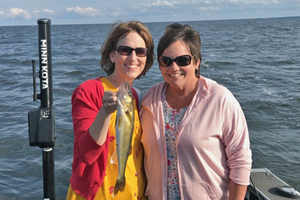 As a longtime guide on Mille Lacs, not only does Jon know the ins and outs of walleye locations on the big lake, but he knows what to rig up in order to catch them. So too does he know how to instruct folks on what to do in order to make a plan come together. It didn’t take very long for him to revert into “guide mode”, sharing whatever information he thought we’d need to know in order to catch a fish.
As a longtime guide on Mille Lacs, not only does Jon know the ins and outs of walleye locations on the big lake, but he knows what to rig up in order to catch them. So too does he know how to instruct folks on what to do in order to make a plan come together. It didn’t take very long for him to revert into “guide mode”, sharing whatever information he thought we’d need to know in order to catch a fish.
“Road Hunting” for walleyes was the plan; Jon would drive the boat and watch for fish on the screen of his Humminbird. Whenever he sighted fish, we’d be instructed to drop our lures, Lindy Live Bait Jigs tipped with leeches and suspended below slip floats. We’d let them drift through the area where fish were spotted and wait for the slip bobber to go under the water. “When the float goes under; take up the slack, set the hook and reel ‘em in” Jon said.
It didn’t take too long for the first pull down, but un-practiced at the presentation, we missed the first one. The 2nd chance worked out better for the Hippie Chick, she caught the first and her first Mille Lacs walleye ever. After a quick photo session she slipped the fish back into the water just in time for Amy to catch one too. After missing a couple of fish, Jon gave me some pointers about how to get the hook set “just right” and that led me to catching a couple of fish too.
Our mission was complete, we enjoyed a couple of nice hours on the water and everyone caught at least one of the target species. The dozen leeches we started with were all gone, so it was time for a speedy boat ride back to camp where we’d relax some more, eat some more and then call it a day; a good day at that!
I’ve heard it said time and time again; “you’re never supposed to guide the guide”. I’ve always known that this advice is solid, but it’s not too often that I get to try using the advice on myself. I’m really glad that I did though and I’m thoroughly happy for the chance to learn a couple of new tricks. I’d do it again tomorrow, but I’m afraid that I have to go back to being the guide again myself. You never know, maybe I’ll be able to schedule the next “professional leech installation” without waiting quite as long as I did this time. ![]() - Jeff Sundin 218-245-9858 or EMAIL
- Jeff Sundin 218-245-9858 or EMAIL
Related Video >> Road Hunting Walleye On Mille Lacs
![]() Jeff Sundin Fishing Report September 1, 2018 "Finding The Findable"
Jeff Sundin Fishing Report September 1, 2018 "Finding The Findable"
 Activity on and around the lakes intensified late Friday afternoon as Labor Day vacationers began arriving at Itasca Area resorts. Soggy weather held many at bay, but we could see the campgrounds on Cutfoot Sioux filling up and there were waiting lines at some of the more popular gas stations.
Activity on and around the lakes intensified late Friday afternoon as Labor Day vacationers began arriving at Itasca Area resorts. Soggy weather held many at bay, but we could see the campgrounds on Cutfoot Sioux filling up and there were waiting lines at some of the more popular gas stations.
Crappie fishing, a popular fall pursuit on both Cutfoot and Little Cutfoot Sioux lakes was obviously on the minds of most anglers who were fishing yesterday. Many of the more reliable Crappie locations had boats on them and for me; it was tricky to find a “fresh school” of fish. In fact, after picking away at the weedlines in pursuit of a multi-species mix, I’d decided that most of the lakes sunfish, walleye, pike, perch and crappie were hunkered down, avoiding contact with I and my crew.
“Before we run out on the big lake, let’s just try one more spot, an offbeat little bay where crappies sometimes go when they’ve been pressured”. It wasn’t long after saying those words to Tom and Laura that we began catching fish, in fact there was enough action to call it a rally, especially for Tom who had the knack for getting the fish to strike.
In my opinion, the fish were there because of being pushed out of more popular areas by angling pressure. The upshot for you this weekend might be to watch for areas adjacent to productive crappie water where nobody else is fishing.
With surface water temperatures hovering at 69 degrees, most of the panfish, crappies included remain weed bound. We’ve searched for them in some of the classic fall areas and for the most part, they have not yet arrived. I think the strategy for this weekend is to stick with the weeds and shoreline breaks; if you do, you will find some fish. ![]() - Jeff Sundin 218-245-9858 or EMAIL
- Jeff Sundin 218-245-9858 or EMAIL
 Lake Winnibigoshish, Joe Thompson, September 1, 2018 Four Seasons Resort
Lake Winnibigoshish, Joe Thompson, September 1, 2018 Four Seasons Resort
"There is not much new to report on the walleye fishing front. They are still being caught in the normal ways. Most of our guest have been targeting the more "catchable" fish, which are northerns and perch. The walleyes that have been coming in have been caught on jigs and minnows while fishing for the previously mentioned fish.
Most of the perch are coming from the flats adjacent to the deeper water. Some key areas are from Richards Townsite boat landing all the way to the River Mouth. The flat between Raven's Point and Mallard is a similar program. There haven't been the massive schools of perch that we encountered last season, but if you keep at it, you can get a nice bunch of fish over 9".
Northerns are being caught in all of the usual ways. Again, look to the flats with deep water close by. The weeds on the north shore are also producing nice pike. Numerous fish over the 22-26" slot have been caught. Trolling or casting large spoons may be the best method
to catch the bigger pike.
It definitely has that fall feeling in the air. The fish will go on the feedbag to prepare for winter. They will be hungry and eager to bite.
We have openings for the next six weeks. Don't for get our fall special runs on all cabin reservations for the remainder of the season. Look forward to seeing you this fall." — Joe Thompson, Four Seasons Resort 218-665-2231
 Jeff Sundin Fishing Report August 31, 2018 "Easing In To Early Fall Fishing Patterns"
Jeff Sundin Fishing Report August 31, 2018 "Easing In To Early Fall Fishing Patterns"
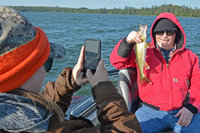 Yesterday morning, during my segment of The Morning Show on KAXE Radio, I mentioned that anglers might anticipate an uptick in Perch activity on Lake Winnie. That was assuming that weather and timing would be similar to those that started the great perch run that anglers enjoyed during early fall of the 2017 fishing season. Right on cue, I received an email note from Eric Stone overnight about his groups fishing trip to Winnie during the early part of this week.
Yesterday morning, during my segment of The Morning Show on KAXE Radio, I mentioned that anglers might anticipate an uptick in Perch activity on Lake Winnie. That was assuming that weather and timing would be similar to those that started the great perch run that anglers enjoyed during early fall of the 2017 fishing season. Right on cue, I received an email note from Eric Stone overnight about his groups fishing trip to Winnie during the early part of this week.
“The water temperature dropped to 67 degrees early mornings Lake Winnie. (The) Perch bite was fantastic; we had to sort some to find the larger perch in the 9 to 11-1/2 inch range. Perch were caught with minnows in 15 feet of water on weed edges.
Storms and water temp made walleye bite tough over the week. But we did manage some below the slot, some in the slot and a couple over the slot.
For Northern Pike, it was hammer time; there were lots of fish in the ..." Read >> Fishing Report August 31, 2018
 There have been a lot of calls and emails lately from readers asking for one sort of advice or another. I’m doing my best to keep up and at the same time, prioritize the list so that I get to the really pressing issues first.
There have been a lot of calls and emails lately from readers asking for one sort of advice or another. I’m doing my best to keep up and at the same time, prioritize the list so that I get to the really pressing issues first.
Since the “busy season” is in full swing, my office time is really limited. So if you’ve dropped me a line and haven’t received a reply, I apologize, I will get the stack cleared up eventually, so please bear with me.
I’m usually checking messages during the wee hours of early morning, so my schedule tends to favor emails rather than phone calls. Also, I do offer The Early Bird Insider’s News List, an “opt-in” email list that I routinely use for announcing last minute openings, special announcement and fishing events. List membership is free and it only takes a few seconds to register. I can’t sign you up; you need to do this yourself by clicking the link to the news list. ![]()
One final thought, every fishing question that I’ve received for the past week has been about lakes and situations that I have already written about. The fishing archives are jam packed with information about the specific lakes and situations that you’ve been asking about. So if you want a jump start on your next fishing trip, go to Fishing Report Archives, select the month that you plan to fish and peruse the past reports. I promise that you will find the information you’re looking for, plus a lot more. ![]() - Jeff Sundin 218-245-9858 or EMAIL
- Jeff Sundin 218-245-9858 or EMAIL
"The Early Bird Fishing Guide" Jeff Sundin - Fishing Blue Books, LLC 715 Byington Ave, LaPrairie, MN 55744 218-245-9858
Email copyright©2018 Fishing Blue Books, LLC All Rights Reserved - last revised 10-2-18
Home | Current Fishing Report | Saved Fishing Reports | Favorite Lakes | Fishing Articles Section | Recipes | Rates Services | Gift Certificates | Contact | For Sale | Links | Sitemap |